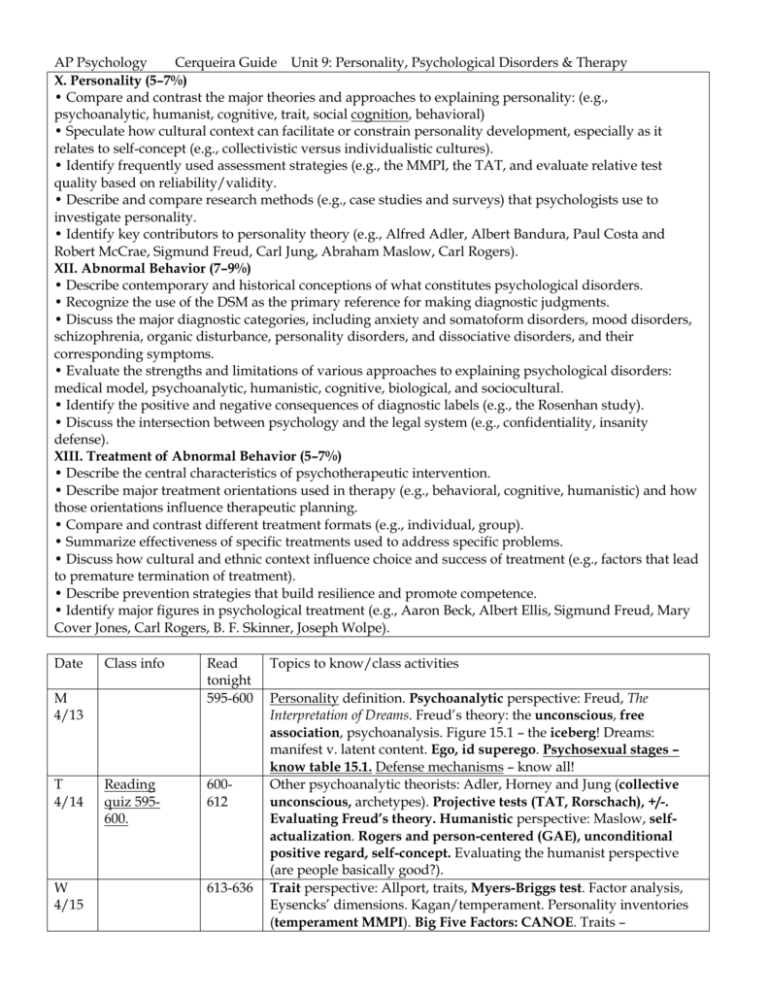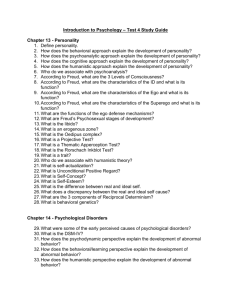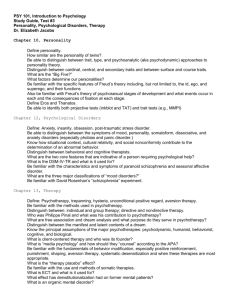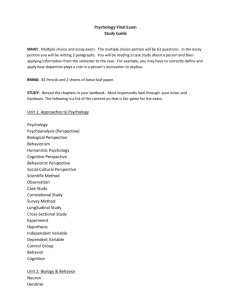Cerqueira guide - abnormal disorders only
advertisement

AP Psychology Cerqueira Guide Unit 9: Personality, Psychological Disorders & Therapy X. Personality (5–7%) • Compare and contrast the major theories and approaches to explaining personality: (e.g., psychoanalytic, humanist, cognitive, trait, social cognition, behavioral) • Speculate how cultural context can facilitate or constrain personality development, especially as it relates to self-concept (e.g., collectivistic versus individualistic cultures). • Identify frequently used assessment strategies (e.g., the MMPI, the TAT, and evaluate relative test quality based on reliability/validity. • Describe and compare research methods (e.g., case studies and surveys) that psychologists use to investigate personality. • Identify key contributors to personality theory (e.g., Alfred Adler, Albert Bandura, Paul Costa and Robert McCrae, Sigmund Freud, Carl Jung, Abraham Maslow, Carl Rogers). XII. Abnormal Behavior (7–9%) • Describe contemporary and historical conceptions of what constitutes psychological disorders. • Recognize the use of the DSM as the primary reference for making diagnostic judgments. • Discuss the major diagnostic categories, including anxiety and somatoform disorders, mood disorders, schizophrenia, organic disturbance, personality disorders, and dissociative disorders, and their corresponding symptoms. • Evaluate the strengths and limitations of various approaches to explaining psychological disorders: medical model, psychoanalytic, humanistic, cognitive, biological, and sociocultural. • Identify the positive and negative consequences of diagnostic labels (e.g., the Rosenhan study). • Discuss the intersection between psychology and the legal system (e.g., confidentiality, insanity defense). XIII. Treatment of Abnormal Behavior (5–7%) • Describe the central characteristics of psychotherapeutic intervention. • Describe major treatment orientations used in therapy (e.g., behavioral, cognitive, humanistic) and how those orientations influence therapeutic planning. • Compare and contrast different treatment formats (e.g., individual, group). • Summarize effectiveness of specific treatments used to address specific problems. • Discuss how cultural and ethnic context influence choice and success of treatment (e.g., factors that lead to premature termination of treatment). • Describe prevention strategies that build resilience and promote competence. • Identify major figures in psychological treatment (e.g., Aaron Beck, Albert Ellis, Sigmund Freud, Mary Cover Jones, Carl Rogers, B. F. Skinner, Joseph Wolpe). Date Class info M 4/13 T 4/14 W 4/15 Reading quiz 595600. Read tonight 595-600 600612 613-636 Topics to know/class activities Personality definition. Psychoanalytic perspective: Freud, The Interpretation of Dreams. Freud’s theory: the unconscious, free association, psychoanalysis. Figure 15.1 – the iceberg! Dreams: manifest v. latent content. Ego, id superego. Psychosexual stages – know table 15.1. Defense mechanisms – know all! Other psychoanalytic theorists: Adler, Horney and Jung (collective unconscious, archetypes). Projective tests (TAT, Rorschach), +/-. Evaluating Freud’s theory. Humanistic perspective: Maslow, selfactualization. Rogers and person-centered (GAE), unconditional positive regard, self-concept. Evaluating the humanist perspective (are people basically good?). Trait perspective: Allport, traits, Myers-Briggs test. Factor analysis, Eysencks’ dimensions. Kagan/temperament. Personality inventories (temperament MMPI). Big Five Factors: CANOE. Traits – Th 4/16 651-59 F 4/17 661-669 M 4/20 671-682 T 4/21 Reading quiz 671-682 684-691 SKIM THESE PAGES as you take notes: 693-701 situational? Social-cognitive perspective: Bandura, reciprocal determinism (fig. 15.6). Internal v. external LOC. Seligman: learned helplessness. Optimism vs. pessimism. (Review explanatory styles.) Positive psychology. Situational assessment. The self: spotlight effect, self-esteem. Self-serving bias. Psychological disorders: how to define, understand and classify? (disturbing/dysfunctional, maladaptive, distressful – and often deviant/abnormal (ask Jones) How deviance is defined – note the example of homosexuality in 1973. ADHD (p.652). Ways of understanding: medical model, biopsychosocial (be aware of culturebound disorders, but don’t memorize). Fig. 65-1. Classifying disorders: the DSM-5 ( ) – skim the changes. The power of labeling: Rosenhan’s experiment, stereotypes/stigma and self-fulfilling prophechies. Insanity and responsibility. Rates: can you tell the most common disorder? How does the US compare to the world? p.658: what makes us resist and be vulnerable to disorders? (nature/nurture) Anxiety disorders: GAD, panic disorder (panic attacks), phobias (know symptoms of each). Do not learn lists of phobias: main ones to know are agoraphobia and social anxiety disorder. OCD: obsessions are ____ and compulsions are ____. See 66.1. Common compulsions? checking & cleaning. PTSD: who gets it, why’s it overdiagnosed, resiliency). Explanations: learning, biological (know examples of each), and brain changes. NOTE: This section should be called DEPRESSIVE DISORDERS, not mood disorders. Major depressive disorders (five signs/2 weeks – see 67.1). #1 reason for ___? Persistent depressive disorder (dysthymia). Bipolar disorder (old name “manic-depression,” mania, link w/creativity). Note seasonal pattern (FYI, p. 673). Summarize the GREAT info on depression (67-2). Explanations: biological (genetic, brain changes) and social-cognitive (know examples of each). Rumination. Explanatory styles (p. 680 & fig 67.5: stable, global, internal). Vicious cycle (fig. 16.9) – “bad moods feed on themselves.” Schizophrenia: “split mind,” not split personality. (It’s a psychosis – ask Jones about neurosis). S terms to know: Delusions v. hallucinations (which sense?), paranoia, word salad, disturbed thinking from selective inattention. Emotions: inappropriate/flat affect and behaviors: repetitive, even catatonia. 68-2: age of onset, prevalence (__%), equal gender, role of stress. Negative and positive symptoms. Acute v. chronic. Explanations: brain (dopamine, PET scans, maternal virus (!), genetic, psychological factors (possible warning signs 690). Somatic symptom and related disorders (this is very confusing!). As you read about/take notes on somatic symptom disorder and conversion disorder, consider this from the DSM-5: “In conversion disorder, the presenting symptom is loss of function (e.g., of a limb), whereas in somatic symptom disorder, the focus is on the distress that particular symptoms cause.” Illness anxiety disorder (hypochondriasis) = normal symptoms are _______? Dissociative disorders: what’s dissociation (normal) vs. what’s DID (really complex – and is it real?) Read the final paragraph p. 696. Eating disorders: distinguish between anorexia and bulimia and W 4/22 Th 4/23 F 4/24 M 4/27 T 4/28 Content quiz: 708-13, anxiety, 716-725 OCD, PTSD, depressive & schizophrenia disorders. 728-37 binge-eating (similarities? Differences?) Personality disorders: what are they (in general) and FOCUS on antisocial. Still to come! Still to come! 740-748 Still to come! ----- Review Test, Unit 9 NOTE: THIS TEST COUNTS AS 2 TEST GRADES!









